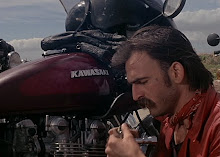Continuing the topic of new suspension components, it's time to put the new bits on the bike. This is where the fun really begins.
First, the front suspension has to be disassembled. This means the bike goes up on the jack:
The front wheel has to come off and that requires removing the front brake caliper and speedometer drive. Watch for the speedo cable to come slithering out of its sheathing. After the front wheel is off, the front fender can come off. Wrap the brake caliper over the left turn signal to get it out of the way.
With the front end disassembled, the fork tubes can come out. I did one side at a time to make sure fork alignment stayed the same. Loosen to hex-head bolts on the upper and lower triple clamps and slide the fork out. With the fork out, we head to the basement to swap the internals.
The first step is to take the fork cap off and drain the old fluid. Keep your distance from the fork cap as it is under pressure and will go flying when you loosen it all the way. Remove the stock spacer, washer and spring. Drain the old fluid and compress and release the fork a few times to get as much fluid out as you can. You should be able to fill up a small jar with fluid like this:
According to the instructions provided with the springs, the fluid level has to be 140mm from the top of the fork tube. 140mm is 5.5 inches so grab a ruler and a clamp and measure the fluid. I used 5w fork oil from Bel-Ray.
With the fork oil at the proper level, we can now install the new spring. The new spring is significantly longer than the old spring so a new spacer will have to be cut out of the supplied PVC pipe to get the proper level of preload. Since the spacer decides the amount of preload, its length will have to be calculated. Progressive Suspension provides a handy chart of spacer lengths for different motorcycles. The chart shows 2001-2007 Triumph Bonnevilles requiring a 3-inch spacer. For my 2008, I will have to calculate how long of a spacer I'll need. For now, I'm going with the 3-inch spacer and if it's too much preload, I'll cut it down at a later date.
Here is the new spring, the old spring, the new spacer and the old spacer:
There is quite a difference between them. With the fork back in the vise, place the spring, washer and spacer in the fork tube. Install the fork cap back onto the fork tube. You'll have to push down on the spacer to install the fork cap. The cap is aluminum and the fork tube is steel, so be careful not to muck up the threads as you tighten down on the cap. Don't tighten the cap yet, wait until the fork is back on the bike before doing that.
Back up in the garage, we can now reinstall the fork tube on the bike. Slide the tube up through the triple clamps and make sure the top of the tube (not the top of the cap) is even with the top of the upper triple clamp. Slide the front axle through its hole in the fork bottoms to align it correctly and then tighten the triple clamp bolts. The procedure is the same for the other side. When you are done, the bike should look like this:
Now for the rear shocks. Really, they couldn't be any easier to install. I chose to change them with the bike off the jack because I'm difficult. All you have to do is loosen the bolts on the shock, remove the shock and place the new one on the bike. Tighten the bolts and you're done. You have to do one side at a time and you will have to lift the bike up a bit as it will sag with only one shock unit on. Check out how good the Hagon 2810s look:
Awesome.
Now for the test ride. Initial riding shows the front to be a little stiff. I may adjust the preload via spacer length or I may spring for Thruxton adjustable preload caps. Aside from a little stiffness, the front of the bike is amazing. There's no bounce and no pogo effect; just smooth, progressive dampening. Turn-in is nice and crisp and requires nothing but a nudge on the bars.
The back of the bike is just as good. I started with the shocks on the softest setting and it was too soft. The back felt like a mid-seventies Cadillac - too much float. Two clicks up from soft and all is well. The bike feels secure and planted and all of the harshness is gone.
It's amazing how a few simple changes will totally alter a motorcycle's character. The Bonneville went from jarring and bouncy to smooth and taut. I'll probably play with the suspension settings a little more as time goes on but right now, it's very, very good.
Subscribe to:
Post Comments (Atom)









No comments:
Post a Comment